gearbox Citroen DS5 HYBRID4 2015 1.G Owner's Guide
[x] Cancel search | Manufacturer: CITROEN, Model Year: 2015, Model line: DS5 HYBRID4, Model: Citroen DS5 HYBRID4 2015 1.GPages: 436, PDF Size: 12.72 MB
Page 117 of 436

11 5
DS5_en_Chap04_conduite_ed01-2015
Engagement of reverse gear is
accompanied by an audible signal.If the engine does not start:
-
If
N is flashing in the instrument
panel, move the gear lever to
position A then to position N .
-
I
f the message "
foot on the brake "
is displayed, press the brake pedal
f i r m l y. When the engine is idling with the
brakes off, if position R
, A or M is
selected, the vehicle will move off
on its own without any action on the
accelerator.
displays in the instrument panel
When you move the lever, the symbol
corresponding to its position is displayed in the
instrument panel.
N
Neutral
R
Reverse
1, 2, 3, 4, 5, 6
G
ears in manual mode
AUTO
T
his comes on when the automated
mode is selected. It switches off on
changing to manual mode.
S
S
port (Sport setting).F
I
f the message " Foot on the
brake " is displayed in the
instrument panel, press the
brake pedal firmly.
Moving off
F To start the engine, place the gear lever in position N .
F
P
ress the brake pedal down fully.F
S
tart the engine.
F
S
elect a mode (position M or A ) or reverse
(position R).
F
R
elease the parking brake unless it is
programmed to automatic mode.
F
T
ake your foot off the brake pedal, then
accelerate.
AUTO and 1 or R appear in the
instrument panel screen.
Automatic mode
F After starting the vehicle, select position A for enter automatic mode.
AUTO and the gear engaged appear
in the instrument panel screen.
The gearbox is then operating in auto-active
mode, without any action on the part of the
driver. It continuously selects the most suitable
gear, depending on the:
-
s
tyle of driving,
-
p
rofile of the road.For optimum acceleration, for example
when overtaking another vehicle, press
the accelerator pedal firmly past the
point of resistance.
driving
Page 118 of 436
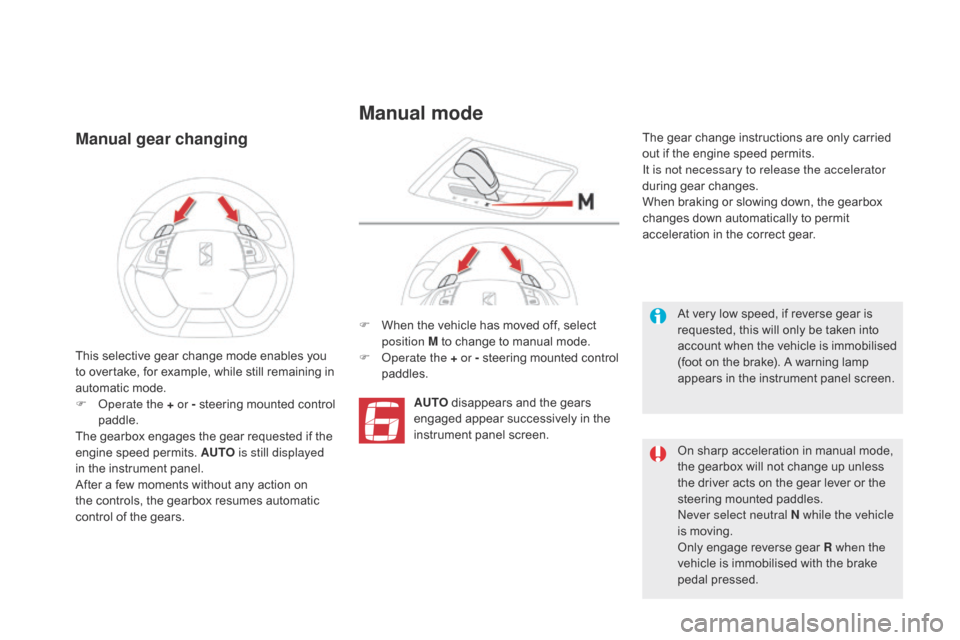
DS5_en_Chap04_conduite_ed01-2015
Manual gear changing
F When the vehicle has moved off, select position M to change to manual mode.
F
O
perate the + or - steering mounted control
paddles.
AUTO disappears and the gears
engaged appear successively in the
instrument panel screen. The gear change instructions are only carried
out if the engine speed permits.
It is not necessary to release the accelerator
during gear changes.
When braking or slowing down, the gearbox
changes down automatically to permit
acceleration in the correct gear.
This selective gear change mode enables you
to overtake, for example, while still remaining in
automatic mode.
F
O
perate the + or - steering mounted control
paddle.
The gearbox engages the gear requested if the
engine speed permits. AUTO is still displayed
in the instrument panel.
After a few moments without any action on
the controls, the gearbox resumes automatic
control of the gears.
Manual mode
At very low speed, if reverse gear is
requested, this will only be taken into
account when the vehicle is immobilised
(foot on the brake). A warning lamp
appears in the instrument panel screen.
On sharp acceleration in manual mode,
the gearbox will not change up unless
the driver acts on the gear lever or the
steering mounted paddles.
Never select neutral N while the vehicle
is moving.
Only engage reverse gear R when the
vehicle is immobilised with the brake
pedal pressed.
Page 119 of 436
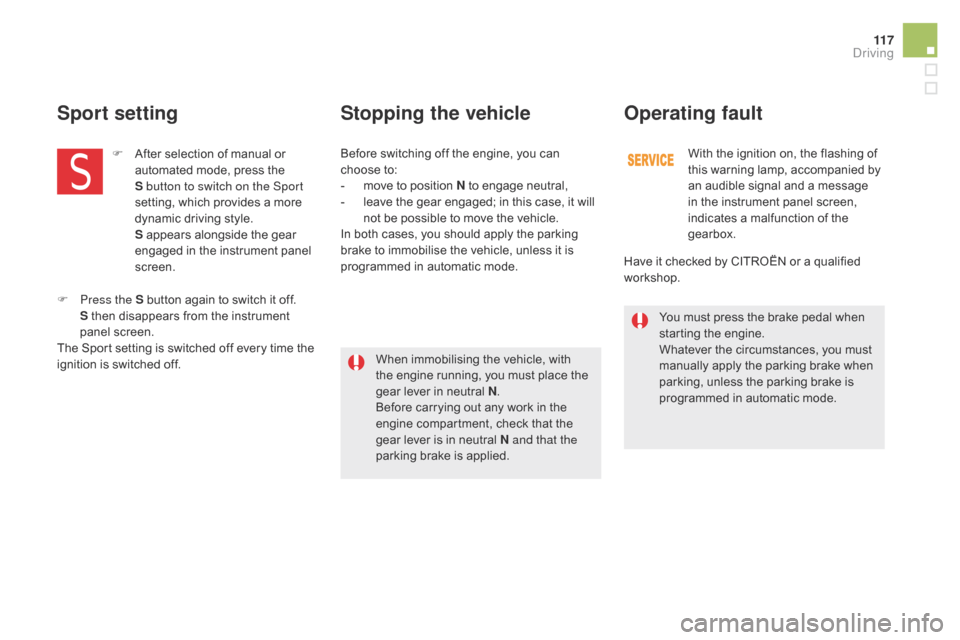
11 7
DS5_en_Chap04_conduite_ed01-2015
You must press the brake pedal when
starting the engine.
Whatever the circumstances, you must
manually apply the parking brake when
parking, unless the parking brake is
programmed in automatic mode.
When immobilising the vehicle, with
the engine running, you must place the
gear lever in neutral N
.
Before carrying out any work in the
engine compartment, check that the
gear lever is in neutral N and that the
parking brake is applied.
Stopping the vehicle
With the ignition on, the flashing of
this warning lamp, accompanied by
an audible signal and a message
in the instrument panel screen,
indicates a malfunction of the
gearbox.
Before switching off the engine, you can
choose to:
-
m
ove to position N to engage neutral,
-
l
eave the gear engaged; in this case, it will
not be possible to move the vehicle.
In both cases, you should apply the parking
brake to immobilise the vehicle, unless it is
programmed in automatic mode.
Operating fault
Sport setting
F After selection of manual or
automated mode, press the
S
button to switch on the Sport
setting, which provides a more
dynamic driving style.
S
appears alongside the gear
engaged in the instrument panel
screen.
F
P
ress the S button again to switch it off.
S
then disappears from the instrument
panel screen.
The Sport setting is switched off every time the
ignition is switched off. Have it checked by CITROËN or a qualified
workshop.
driving
Page 120 of 436
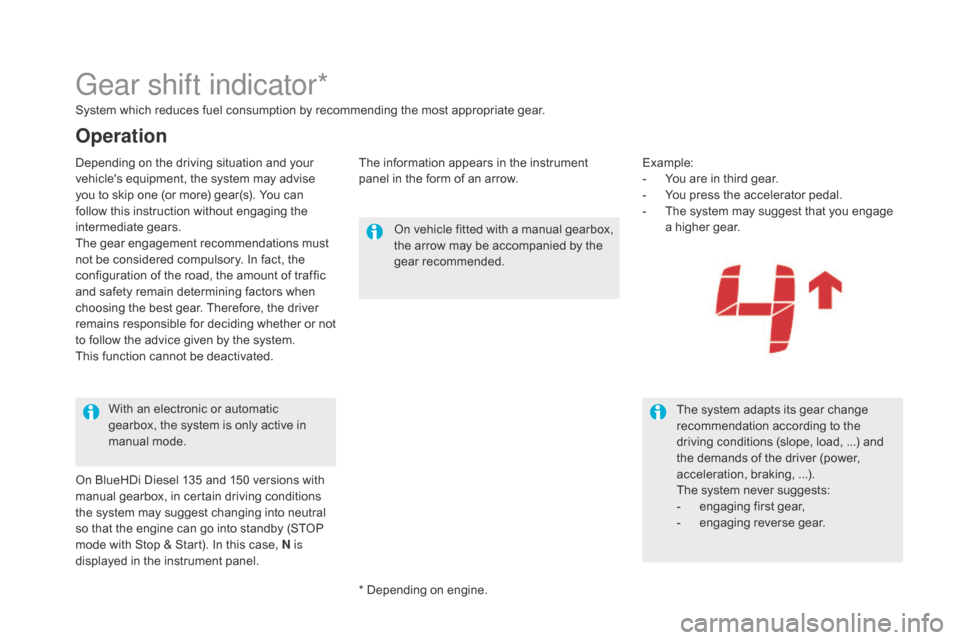
DS5_en_Chap04_conduite_ed01-2015
Gear shift indicator*
System which reduces fuel consumption by recommending the most appropriate gear.The information appears in the instrument
panel in the form of an arrow.Example:
-
Y
ou are in third gear.
-
Y
ou press the accelerator pedal.
-
T
he system may suggest that you engage
a higher gear.
On vehicle fitted with a manual gearbox,
the arrow may be accompanied by the
gear recommended.
The system adapts its gear change
recommendation according to the
driving conditions (slope, load, ...) and
the demands of the driver (power,
acceleration, braking, ...).
The system never suggests:
-
e
ngaging first gear,
-
enga
ging reverse gear.
With an electronic or automatic
gearbox, the system is only active in
manual mode.
Operation
* Depending on engine.
Depending on the driving situation and your
vehicle's equipment, the system may advise
you to skip one (or more) gear(s). You can
follow this instruction without engaging the
intermediate gears.
The gear engagement recommendations must
not be considered compulsory. In fact, the
configuration of the road, the amount of traffic
and safety remain determining factors when
choosing the best gear. Therefore, the driver
remains responsible for deciding whether or not
to follow the advice given by the system.
This function cannot be deactivated.
On BlueHDi Diesel 135 and 150 versions with
manual gearbox, in certain driving conditions
the system may suggest changing into neutral
so that the engine can go into standby (STOP
mode with Stop & Start). In this case, N is
displayed in the instrument panel.
Page 123 of 436
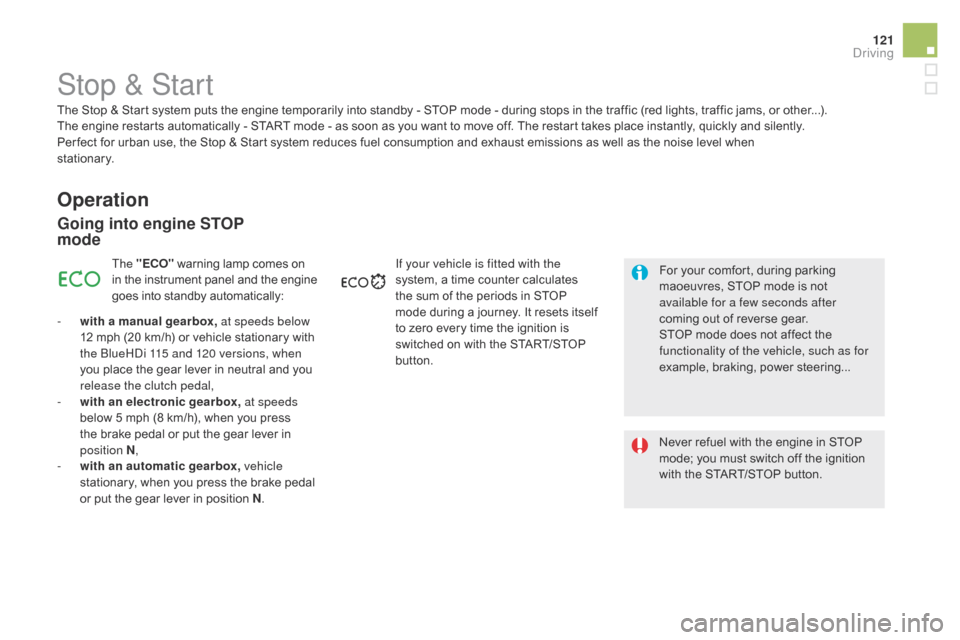
121
DS5_en_Chap04_conduite_ed01-2015
Stop & Start
Operation
Going into engine STOP
mode
The "E cO" warning lamp comes on
in the instrument panel and the engine
goes into standby automatically:
-
w
ith a manual gearbox, at speeds below
12 mph (20 km/h) or vehicle stationary with
the BlueHDi 115 and 120 versions, when
you place the gear lever in neutral and you
release the clutch pedal,
-
w
ith an electronic gearbox, at speeds
below 5 mph (8 km/h), when you press
the brake pedal or put the gear lever in
position
N,
-
w
ith an automatic gearbox, vehicle
stationary, when you press the brake pedal
or put the gear lever in position N .If your vehicle is fitted with the
system, a time counter calculates
the sum of the periods in STOP
mode during a journey. It resets itself
to zero every time the ignition is
switched on with the START/STOP
button.
Never refuel with the engine in STOP
mode; you must switch off the ignition
with the START/STOP button. For your comfort, during parking
maoeuvres, STOP mode is not
available for a few seconds after
coming out of reverse gear.
STOP mode does not affect the
functionality of the vehicle, such as for
example, braking, power steering...
The Stop & Start
system puts the engine temporarily into standby - STOP mode - during stops in the traffic (red lights, traffic jams, or other...).
The
engine restarts automatically - START mode - as soon as you want to move off. The restart takes place instantly, quickly and silently.
Per fect for urban use, the Stop & Start system reduces fuel consumption and exhaust emissions as well as the noise level when
stationary.
driving
Page 124 of 436
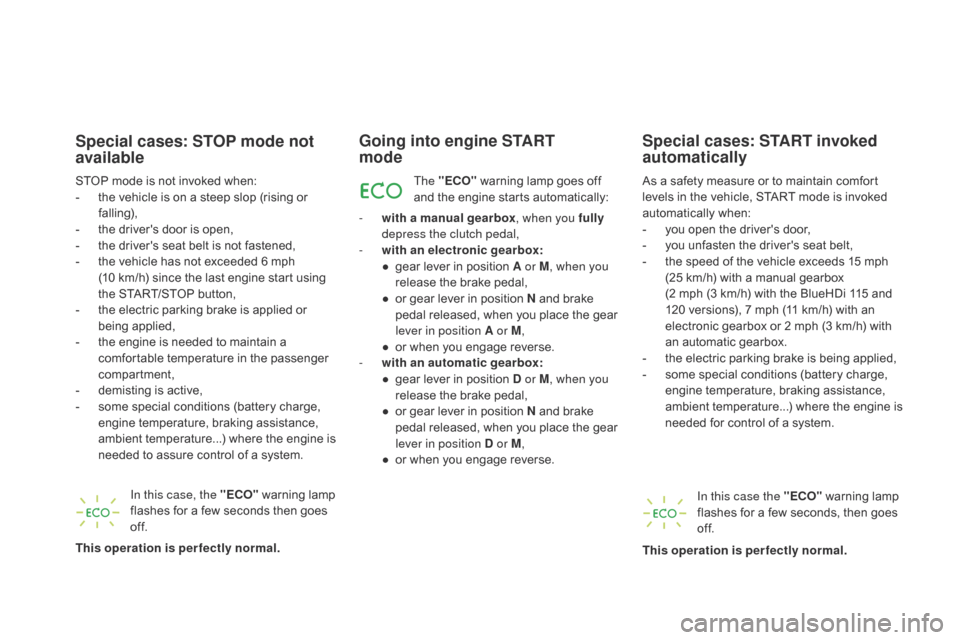
DS5_en_Chap04_conduite_ed01-2015
Special cases: STOP mode not
available
STOP mode is not invoked when:
- t he vehicle is on a steep slop (rising or
falling),
-
t
he driver's door is open,
-
t
he driver's seat belt is not fastened,
-
t
he vehicle has not exceeded 6 mph
(10
km/h) since the last engine start using
the START/STOP button,
-
t
he electric parking brake is applied or
being applied,
-
t
he engine is needed to maintain a
comfortable temperature in the passenger
compartment,
-
d
emisting is active,
-
s
ome special conditions (battery charge,
engine temperature, braking assistance,
ambient temperature...) where the engine is
needed to assure control of a system.
In this case, the "E
c
O
" warning lamp
flashes for a few seconds then goes
of f.
This operation is perfectly normal.
Going into engine START
mode
The "EcO" warning lamp goes off
and the engine starts automatically:
-
w
ith a manual gearbox , when you fully
depress the clutch pedal,
-
w
ith an electronic gearbox:
●
g
ear lever in position A or M , when you
release the brake pedal,
●
o
r gear lever in position N and brake
pedal released, when you place the gear
lever in position A or M ,
●
o
r when you engage reverse.
-
w
ith an automatic gearbox:
●
g
ear lever in position d or M, when you
release the brake pedal,
●
o
r gear lever in position N and brake
pedal released, when you place the gear
lever in position
d or M,
●
o
r when you engage reverse. As a safety measure or to maintain comfort
levels in the vehicle, START mode is invoked
automatically when:
-
y
ou open the driver's door,
-
y
ou unfasten the driver's seat belt,
-
t
he speed of the vehicle exceeds 15 mph
(25 km/h) with a manual gearbox
(2 mph (3 km/h) with the BlueHDi 115 and
120 versions), 7 mph (11 km/h) with an
electronic gearbox or 2 mph (3 km/h) with
an automatic gearbox.
-
t
he electric parking brake is being applied,
-
s
ome special conditions (battery charge,
engine temperature, braking assistance,
ambient temperature...) where the engine is
needed for control of a system.
Special cases: START invoked
automatically
In this case the "EcO " warning lamp
flashes for a few seconds, then goes
of f.
This operation is perfectly normal.
Page 138 of 436
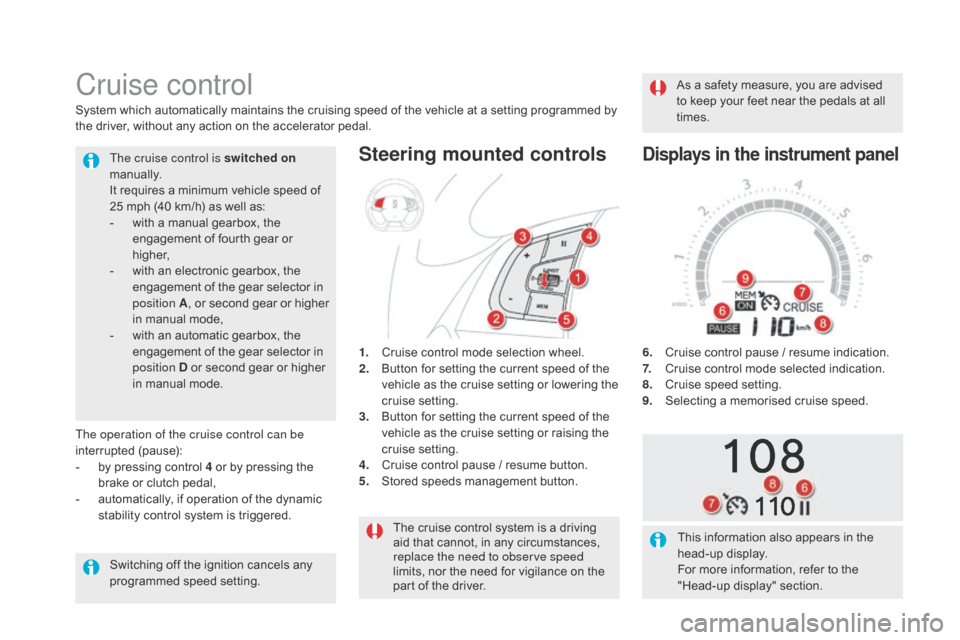
DS5_en_Chap04_conduite_ed01-2015
The cruise control system is a driving
aid that cannot, in any circumstances,
replace the need to observe speed
limits, nor the need for vigilance on the
part of the driver.
Cruise control
1. Cruise control mode selection wheel.
2. Button for setting the current speed of the
vehicle as the cruise setting or lowering the
cruise setting.
3.
B
utton for setting the current speed of the
vehicle as the cruise setting or raising the
cruise setting.
4.
C
ruise control pause / resume button.
5.
S
tored speeds management button.
Steering mounted controls
6. Cruise control pause / resume indication.
7. C ruise control mode selected indication.
8.
C
ruise speed setting.
9.
S
electing a memorised cruise speed.
displays in the instrument panelThe cruise control is switched on
manually.
It requires a minimum vehicle speed of
25 mph (40 km/h) as well as:
-
w
ith a manual gearbox, the
engagement of fourth gear or
higher,
-
w
ith an electronic gearbox, the
engagement of the gear selector in
position A, or second gear or higher
in manual mode,
-
w
ith an automatic gearbox, the
engagement of the gear selector in
position
d or second gear or higher
in manual mode.
This information also appears in the
head-up display.
For more information, refer to the
"Head-up display" section.
System which automatically maintains the cruising speed of the vehicle at a setting programmed by
the driver, without any action on the accelerator pedal.
Switching off the ignition cancels any
programmed speed setting.
The operation of the cruise control can be
interrupted (pause):
-
b
y pressing control 4 or by pressing the
brake or clutch pedal,
-
a
utomatically, if operation of the dynamic
stability control system is triggered. As a safety measure, you are advised
to keep your feet near the pedals at all
times.
Page 210 of 436
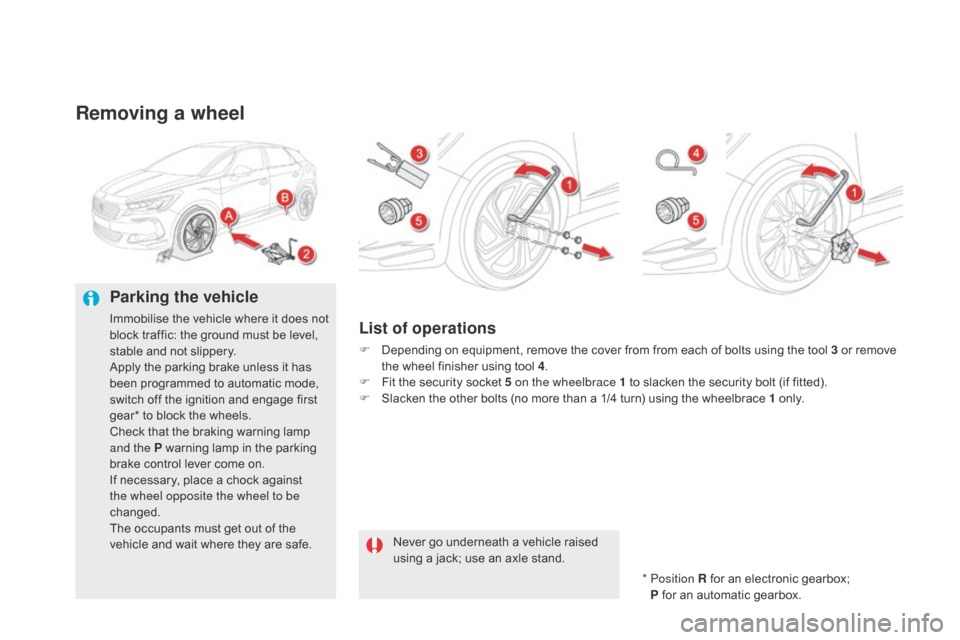
DS5_en_Chap08_info-pratiques_ed01-2015
Removing a wheel
Parking the vehicle
Immobilise the vehicle where it does not
block traffic: the ground must be level,
stable and not slippery.
Apply the parking brake unless it has
been programmed to automatic mode,
switch off the ignition and engage first
gear* to block the wheels.
Check that the braking warning lamp
and the P warning lamp in the parking
brake control lever come on.
If necessary, place a chock against
the wheel opposite the wheel to be
changed.
The occupants must get out of the
vehicle and wait where they are safe.List of operations
F Depending on equipment, remove the cover from from each of bolts using the tool 3 or remove the wheel finisher using tool 4 .
F
F
it the security socket 5 on the wheelbrace 1 to slacken the security bolt (if fitted).
F
S
lacken the other bolts (no more than a 1/4 turn) using the wheelbrace 1 o n l y.
*
Position R for an electronic gearbox;
P for an automatic gearbox.
Never go underneath a vehicle raised
using a jack; use an axle stand.
Page 228 of 436
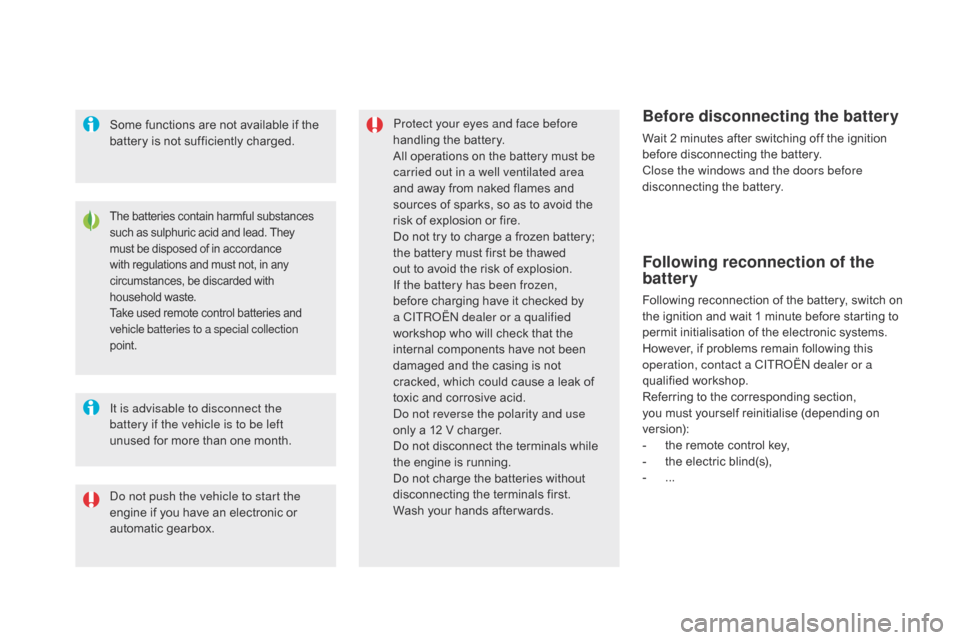
DS5_en_Chap08_info-pratiques_ed01-2015
The batteries contain harmful substances
such as sulphuric acid and lead. They
must be disposed of in accordance
with regulations and must not, in any
circumstances, be discarded with
household waste.
Take used remote control batteries and
vehicle batteries to a special collection
point.
It is advisable to disconnect the
battery if the vehicle is to be left
unused for more than one month.
Do not push the vehicle to start the
engine if you have an electronic or
automatic gearbox.Protect your eyes and face before
handling the battery.
All operations on the battery must be
carried out in a well ventilated area
and away from naked flames and
sources of sparks, so as to avoid the
risk of explosion or fire.
Do not try to charge a frozen battery;
the battery must first be thawed
out to avoid the risk of explosion.
If the battery has been frozen,
before charging have it checked by
a CITROËN dealer or a qualified
workshop who will check that the
internal components have not been
damaged and the casing is not
cracked, which could cause a leak of
toxic and corrosive acid.
Do not reverse the polarity and use
only a 12 V charger.
Do not disconnect the terminals while
the engine is running.
Do not charge the batteries without
disconnecting the terminals first.
Wash your hands after wards.
Before disconnecting the battery
Wait 2 minutes after switching off the ignition
before disconnecting the battery.
Close the windows and the doors before
disconnecting the battery.
Following reconnection of the
battery
Following reconnection of the battery, switch on
the ignition and wait 1 minute before starting to
permit initialisation of the electronic systems.
However, if problems remain following this
operation, contact a CITROËN dealer or a
qualified workshop.
Referring to the corresponding section,
you must yourself reinitialise (depending on
version):
-
t
he remote control key,
-
t
he electric blind(s),
-
...
S
ome functions are not available if the
battery is not sufficiently charged.
Page 231 of 436
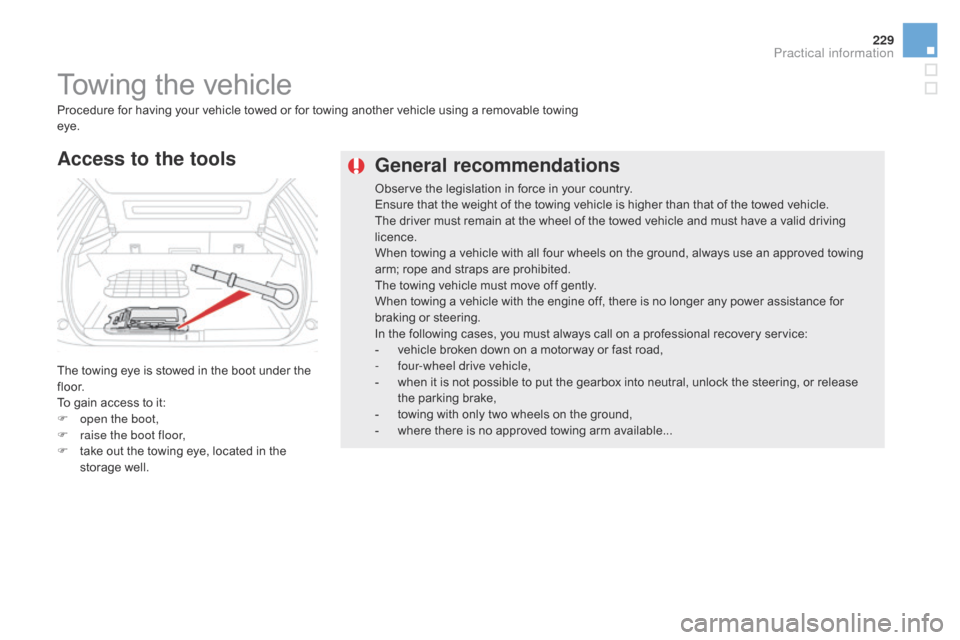
229
DS5_en_Chap08_info-pratiques_ed01-2015
General recommendations
Observe the legislation in force in your country.
Ensure that the weight of the towing vehicle is higher than that of the towed vehicle.
The driver must remain at the wheel of the towed vehicle and must have a valid driving
licence.
When towing a vehicle with all four wheels on the ground, always use an approved towing
arm; rope and straps are prohibited.
The towing vehicle must move off gently.
When towing a vehicle with the engine off, there is no longer any power assistance for
braking or steering.
In the following cases, you must always call on a professional recovery service:
-
v
ehicle broken down on a motor way or fast road,
-
f
our-wheel drive vehicle,
-
w
hen it is not possible to put the gearbox into neutral, unlock the steering, or release
the parking brake,
-
t
owing with only two wheels on the ground,
-
w
here there is no approved towing arm available...
Towing the vehicle
Access to the tools
The towing eye is stowed in the boot under the
f l o o r.
To gain access to it:
F
o
pen the boot,
F
r
aise the boot floor,
F
t
ake out the towing eye, located in the
storage well.
Procedure for having your vehicle towed or for towing another vehicle using a removable towing
eye.
Practical information